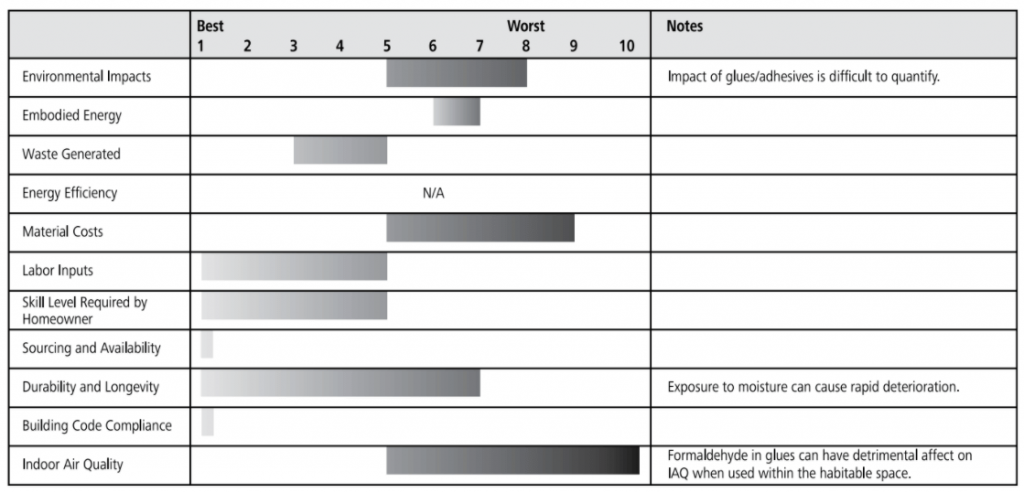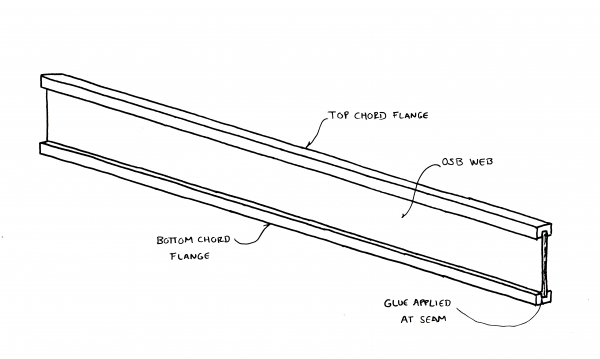wood i-beams
Floor & Roof Structure: MATERIALS ENCYcLOPEDIA
Applications for this system
Floor and roof framing
Basic materials
Solid or laminated wood top and bottom cords
Oriented strand board (OSB)
Glue to connect OSB to cords
Ratings Chart for wood i-beam floor and roof

The ratings chart shows comparative performance in each criteria category. Click on the tabs below for detailed analysis of each criteria.
- HOW THE SYSTEM WORKS
- ENVIRONMENTAL IMPACTS
- WASTE
- EMBODIED CARBON
- ENERGY EFFICIENCY
- MATERIAL COSTS
- LABOUR INPUT
- SKILL LEVEL REQUIRED
- SOURCING & AVAILABILITY
- DURABILITY
- CODE COMPLIANCE
- INDOOR AIR QUALITY
- RESOURCES
- FUTURE DEVELOPMENT
wood i-beam System
 An I-beam is created using dimensional lumber or laminated veneer lumber as wide top and bottom cords, slotted to accept a sheet of thin, oriented strand board (OSB) that is glued into the cords to create a deep, thin beam that can be used for floor joists and roof framing. Special fastening brackets and I-joist blocking are used to make connections and bracing in the system.
An I-beam is created using dimensional lumber or laminated veneer lumber as wide top and bottom cords, slotted to accept a sheet of thin, oriented strand board (OSB) that is glued into the cords to create a deep, thin beam that can be used for floor joists and roof framing. Special fastening brackets and I-joist blocking are used to make connections and bracing in the system.
I-beams are ordered at the appropriate lengths for the project and different depths are available to handle particular spans and loads. I-beam suppliers provide engineering to ensure that appropriate depths and spacing are matched to loads and spans.
Manufactured I-beams do not exhibit the same tendencies to warp, split or otherwise distort that are common with solid timber joists.
Environmental Impact Rating
Harvesting — Moderate to High
Unmanaged forestry can have impacts that include significant habitat destruction, soil erosion and ground water contamination. The use of marginal wood stocks for OSB can help to mitigate impacts. Third-party certification can help to ensure that impacts are minimized.
Glues for binding wood fibers are formaldehyde based, and have significant harvesting impacts.
Metal fasteners may seem like a small component, but dozens of kilograms can go into a frame wall. Ore for steel production is mined in an intensive process with impacts including habitat destruction and soil and water contamination.
Manufacturing — Negligible to Moderate
The sawing and planing of structural lumber for I-beam rails is a relatively low–impact mechanical process. Shredding of wood for OSB production has low to moderate impacts.
Glues for binding wood fibers are formaldehyde based, and have significant manufacturing impacts including air and water pollution.
Processing raw ore into nails and screws is a multi-stage and intensive process requiring multiple infusions of high heat and fossil fuel use with impacts including air and water pollution.
Transportation — Negligible to High
Sample building uses 2,547 kg of wooden I-beams for roof and floor:
3.8 MJ per km by 15 ton truck
2.4 MJ per km by 35 ton truck
Timber is a heavy and high-volume material and accrues significant impacts proportional to distance traveled. I-beam manufacturers are relatively well distributed in most regions.
Installation — Negligible to Moderate
The number of offcuts from wood I-beams can be quite high. Careful cut lists and ordering can minimize this waste.
Wooden I-beams represent a quandary that is common in green building. On one hand, this product uses wood fibers in the OSB that would not have been suitable for making dimensional lumber, making use of harvested wood that otherwise would not have been useful for construction. On the other hand, the glues used to bond the wood fibers in the OSB are formaldehyde based, raising environmental concerns during their production, off-gassing concerns within the building and trouble with disposal of offcuts and I-beams at the end of the useful lifespan of the product.
Wooden I-beams can be made from FSC or other third-party certified wood sources, helping to lower environmental impacts.
Waste: moderate
Recyclable – Metal fasteners
Landfill – I-beam offcuts
Chart of Embodied energy & carbon
wood i-beam roof:
wood i-beam floor:
Energy Efficiency
Wooden I-beams are typically deeper than comparable solid lumber joists, offering more depth for insulation. The OSB portion of the I-beam is continuous, creating a cold bridge through the insulation though the bridge is very thin. Properly filled with insulation, a roof and/or floor system built with wooden I-beams can be part of an energy-efficient building enclosure.
Material costs: moderate to high
I-beams are typically more expensive per lineal meter than comparable solid lumber or truss options.
Labour Input: low to moderate
One of the main benefits of manufactured joists is that they are lightweight, making it possible for one or two workers to handle very long spans of joist. The ability of the joists to span greater distances can also reduce labor time as it eliminates joints. Longer spans can also reduce the number of load-bearing walls required in a design, eliminating labor throughout the building process, from the foundation upward.
Skill level required for homeowners: low to moderate
Any builder able to frame a floor or roof with solid lumber will be able to do the same with wooden I-beams. The joists come pre-engineered and will include layout drawings that should be easy for newcomers to follow. Beginners will need to understand basic carpentry skills.
Sourcing & availability: Easy
Wooden I-beams are widely available, usually through building supply centers. An in-house designer and/or engineer will work from a set of plans to determine the depth of joist required and a suitable layout.
Durability: moderate to High
The weakness of wooden I-beams is their durability. Under normal, dry conditions they can have a working life similar to solid wood. However, the OSB portion of the joist does not stand up well to repeated wetting, with the wafers of wood expanding and the glues weakening. Manufacturers insist that the I-beams be kept covered and dry while on the construction site to protect them against this weakening.
Once in a home, these joists should stay dry. However, houses do leak, and when exposed to a constant source of moisture, these joists will deteriorate faster than comparable solid wood options. Because they play a key structural role in a building, deterioration can have major implications.
Code compliance
As a pre-engineered system, wooden I-beams are an accepted solution in most jurisdictions. Building departments will typically want to be provided with a stamped version of the joist drawings as part of the plan submission.
Indoor air quality
The glues used in the OSB portion of the wooden I-beam all contain formaldehyde and will off-gas for a long time. I-beams installed as roof framing will be outside the habitable space and are separated from the indoor air. However, I-beams installed as floor joists will be inside the living space and will contribute to elevated levels of formaldehyde in the air.
Resources for further research
n/a
Future development
A growing number of manufacturers offer FSC or other third-party certified wood sources, and this trend is likely to grow as awareness of certified wood increases. Many manufacturers are working to eliminate or reduce the formaldehyde content in their glues, and a breakthrough in this area would make these products much more attractive from an environmental perspective. Different glues may also resolve water damage issues, further increasing their attractiveness.
Tips for a successful wood i-beam floor or roof
Wooden I-beams are proprietary products, and each will have its own installation guidelines that should be followed closely.
Keep I-beams dry once delivered to your job site— the OSB component does not handle wet conditions very well.





